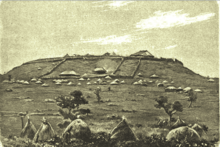Battle of Azule
The Battle of Azule was fought on September 6 1886, between the forces of Ras Darge Sahle Selassie and a force of Arsi Oromo. It was part of a broader series of expansion campaigns done under Menelik II, Negus of Shewa, referred to by some historians as the Agar Maqnat. The battle of Azule was important as it represents the crushing of a large Arsi army by one under Menelik; it also demonstrates the dynamic of gun-wielding Shewans fighting Spear-wielding Oromos that many historians like to stress when discussing Menelik's expansions; it also retains symbolic and historic importance in the politics and identities of many.
| Battle of Azule | |||||
|---|---|---|---|---|---|
| Part of Menelik's Expansions or 'Agar Maqnat' | |||||
| |||||
| Belligerents | |||||
| Forces of the Kingdom of Shewa | Arsi Oromo | ||||
| Commanders and leaders | |||||
| Ras Darge Sahle Selassie | Arsi Oromo | ||||
| Strength | |||||
| 10,000?[1] | ??? | ||||
| Casualties and losses | |||||
| ? | 6-12,000 | ||||
Background

Ras Darge Sahle Selassie arrived in Arsi-country with the Negus Menelik II's army. Though Menelik II eventually left Arsi-country, Darghe stayed and established a Katama (roughly: garrison / camp) at Azule. The Katama had 3 layers, each fortified by a wall. [2]
Battle
Ras Darge Sahle Selassie, through the use of informants, knew of the Arsi plan to attack his Katama on September 6 1886. Therefore, he organized his gunmen along the second wall of his Katama. Darghe planned for his gunmen to hold fire until the Arsi had successfully entered the first layer of his Katama. This way, they would be trapped when the order was given to start gunfire. When the Arsi Oromo attacked, Darghe's gunmen, either scared or triggerhappy, opened fire before Darghe's order. The result was still an overwhelming Shewan success, but many sources record Darghe punishing his commanders, some of whom were his sons. In the months following this victory, Darge subdued the peoples of Arsi-land, but did not move to annex those Arsi living in the southern Bale lands.[3][4]
Citations
- Tafla, Bairu (July 1975). "Ras Dargé Sahle Selassie, c 1827 - 1900". The Journal of African History. 13 (2): 17–37.
- Gnamo, Abbas (23 July 2014). Conquest and Resistance in the Ethiopian Empire, 1880 - 1974: The Case of the Arsi Oromo. Brill. ISBN 978-90-04-25813-6.
References
- Karim, ElAmin (2009). An Historical Study of the Shawan-Amhara Conquest of the Oromo and Sidama Regions of Southern Ethiopia 1865-1900 (Doctoral). University of Khartoum. p. 130.
- Gnamo, Abbas (23 July 2014). Conquest and Resistance in the Ethiopian Empire, 1880 - 1974: The Case of the Arsi Oromo. Brill. ISBN 978-90-04-25813-6.
- Gnamo, Abbas (23 July 2014). Conquest and Resistance in the Ethiopian Empire, 1880 - 1974: The Case of the Arsi Oromo. Brill. ISBN 978-90-04-25813-6.
- Tafla, Bairu (July 1975). "Ras Dargé Sahle Selassie, c 1827 - 1900". The Journal of African History. 13 (2): 17–37.